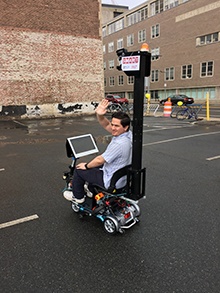In the age of self-driving cars, a new self-driving wheelchair is in development to help people with disabilities
By Courtney Verrill

Roboticists at Massachusetts Institute of Technology (MIT) are currently working on making an autonomous wheelchair that drives itself. MIT Professor Daniela Rus, the head master of the project, got her inspiration to build the self-driving wheelchair after visiting a retirement community in Singapore where she noticed there was not enough staff members to meet every patient’s needs.
“The goal is to provide navigation support for people with limited mobility,” says Rus.

As of right now, there is a working system that is being used for tests and lab settings. The wheelchair will work like a self-driving car. It is equipped with sensors that measure distance to a target by illuminating that target with a laser light, also known as LiDAR sensors. The wheelchair will be manually driven around the area it wants to be used, from that the sensors will build a map, and after that process is complete the user will be able to select where they want to go by clicking on the map.
“A map is made by driving the vehicle on every road or hallway of a closed area where the wheelchair is expected to be used,” says Rus. “Given this map, when a user wants to travel from the current location to the destination, a path is computed to avoid all of the static obstacles in the environment and then executed.
The wheelchair will also pick up new obstacles they encounter on the way, such as people, chairs and other objects that were not integrated with the map, and it will modify those changes to go around the new obstacles in real-time.
Having an autonomous wheelchair in places like a retirement community will help wheelchair users be able to go from room to room without assistance from staff members, which will allow the users to move around freely.
“An autonomous wheelchair can provide a different level of independence for people with limited mobility,” says Rus.
The wheelchair is still in a research phase and being tested locally around Cambridge, Mass. Rus hopes that their autonomous wheelchair will bring broad benefits for people with disabilities.


